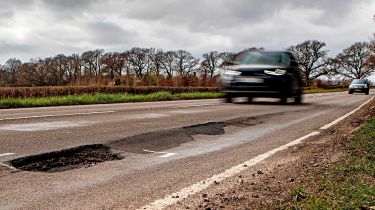Pothole breakdowns surge 9% as more drivers fall victim to Britain's broken roads
Pothole-related breakdowns rose by nine per cent in the second quarter of 2025, following a cold and rainy start to the year

Pothole-related breakdowns hit what has been described as an "unseasonable high” in the second quarter of 2025, indicating a rise in the number of potholes littering UK roads.
Statistics released by the RAC show the number of vehicles attended to at the roadside with damaged shock absorbers, broken suspension springs and distorted wheels – all issues typically caused by hitting a pothole – rose by nine per cent between April and June (6,575 total callouts) compared with the same period in 2024.
Such elevated figures are also highlighted when looking at the long term, because in the 12 months leading up to June of this year, the RAC attended roughly 25,000 pothole-related breakdowns – the equivalent of 68 per day. Compare this with the same period leading up to March of this year, in which 500 fewer breakdowns were attended, and you may wonder what caused such a spike in potholes in what was the late spring and early summer.
While warmer months aren’t typically associated with the creation of potholes – these typically form in the winter when water seeps into cracks in the road, subsequently freezing and causing the gaps to widen – the RAC says the exceptionally wet and cold start to 2025 has resulted in a spike in the number of craters scarring our streets.
There is some hope, however, because local councils received additional road maintenance funding as promised by Keir Starmer’s government at the beginning of the financial year in April.
While it's still too early to see any of the benefits, the RAC’s head of policy, Simon Williams, urged councils to adopt a mindset of “prevention over patching” when it comes to allocating government cash.
“After filling the most severe potholes as permanently as possible, preventative treatments like surface dressing are by far the most effective because they stop potholes appearing in future,” said WIlliams. “Now councils have long-term certainty of funding, they can plan surfacing dressing works, along with resurfacing roads that are beyond repair.”
Of course, it’s worth pointing out that pothole-releated callouts, while proportionally at a seven-year high when it comes to all of the breakdowns the RAC attends, only account for 1.2 per cent of the total.
Nevertheless, chief executive of the Road Surface Treatments Association, Mike Hansford, says preventative treatment is key: “Untreated asphalt roads will naturally degrade over time, leading to the formation of potholes.”
Hansford continued, reiterating that “It is essential to invest in cost-effective preventative road surface treatments to seal the road; preventing water ingress, and to act as a barrier to the elements and the effects of trafficking, keeping roads in good condition for longer and preventing potholes.”
Did you know you can sell your car through Auto Express? We’ll help you get a great price and find a great deal on a new car, too.
Find a car with the experts




